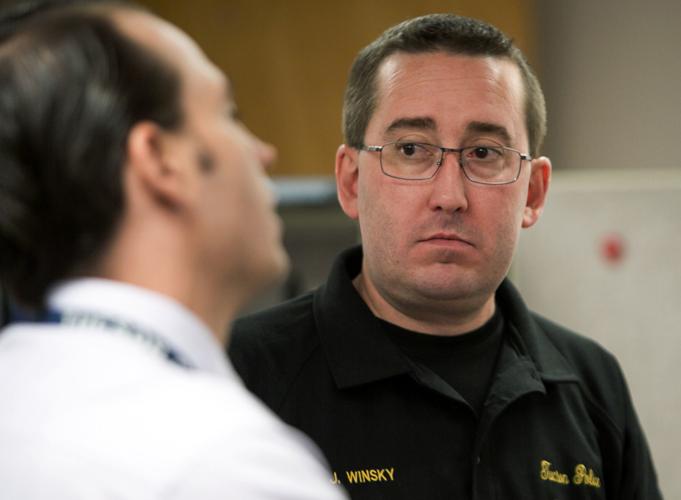Advocates for people with mental illness or substance-use disorders are raising alarms that upheaval in Tucson’s behavioral-health system is pushing more vulnerable people into crisis.
But hard data that could help illuminate how patients are faring has been hard to come by.
When Cenpatico Integrated Care took over management of the Southern Arizona behavioral-health system in 2015, the insurer promised data-driven accountability in its new role as the regional behavioral-health authority for Pima County and seven other counties.
Three-and-a-half-years later, the insurer — now known as Arizona Complete Health — has released little patient-outcome data that could shed light on how its members with behavioral-health needs have fared since it took charge.
Data obtained by the Arizona Daily Star shows trends since 2015 that are worrisome to some Tucson providers and advocates.
Among the concerns:
- An increase in mental-health transports by Tucson police.
- More petitions for court-ordered mental-health evaluations, to determine if a person is a danger to one’s self or others and requires court-ordered treatment.
- And a rise in inpatient psychiatric hospital days for patients with mental illness at at least one large behavioral-health agency.
With many factors at play, including an ongoing opioid crisis, it’s impossible to nail down a single cause of increased reliance on Tucson crisis services. And greater utilization of the Crisis Response Center could be a positive trend, as awareness of the CRC as an alternative to jail continues to grow among law enforcement.
But mental-health advocates say years of Cenpatico’s payment cuts, evolving payment structures and ever-changing demands on behavioral-health agencies are undermining coordination of care for vulnerable patients in Southern Arizona.
Clarke Romans, executive director of the National Alliance on Mental Illness Southern Arizona, or NAMI, said there’s been too little data released publicly — by both Arizona’s Medicaid agency AHCCCS and Arizona Complete Health — to show what taxpayer dollars are paying for.
AHCCCS payments to Arizona Complete Health totaled more than $726 million in the fiscal year that ended in September 2018, compared to $685 million the year prior, according to Arizona Complete Health’s latest financial statement.
“There’s no accountability,” Romans said. “There’s just a giant cloud of mystery around how are people actually being served.”
DATA OBTAINED BY THE STAR
The Star requested patient hospitalization data from three of the biggest behavioral-health agencies in Tucson: La Frontera Arizona, COPE Community Services and CODAC. CODAC declined to share data with the Star. Rod Cook, CEO of COPE Community Services, said the agency’s data wasn’t consistent enough to ensure an apples-to-apples comparison between Cenpatico versus the previous regional behavioral-health authority, which was the nonprofit Tucson-based Community Partnership of Southern Arizona.
A Star analysis of data shared by La Frontera found the number of psychiatric hospitalization days per 1,000 patients has been trending upwards since fiscal year 2013, and the growth accelerated after fiscal year 2016.
In fiscal year 2012, the number of hospital days per 1,000 La Frontera patients was 561, compared to 1,169 in fiscal year 2018, which ended in September. La Frontera had about 6,500 enrolled members that year.
In response to a public-records request, the Tucson Police Department released data showing mental-health transports to the Crisis Response Center or psychiatric hospitals increased from 2,224 in 2013 — the earliest reliable data-year — to 3,366 in 2018.
The crisis center, which opened in 2011, has been a boon for law enforcement agents, who used to have to spend hours waiting at a hospital for a patient in crisis to be received.
Now, they can drop someone off at the center and are received within 10 minutes, said Pima County Sheriff’s Department Sgt. Sean Payne, supervisor of the mental-health support team.
A March data-trends report from the Pima County Behavioral Health department shows the monthly average number of petitions for court-ordered evaluations increased from 147 in fiscal year 2016 to a monthly average of 178 in fiscal year 2018.
But Paula Perrera, department director, emphasized that the figures represent a small subset of the behavioral-health population, and she said it’s hard to draw any broader conclusions from the limited dataset.
“There’s so many variables in the system. I don’t think we have a good enough handle on all of the data that we are in a position to opine,” Perrera said.
For Romans of NAMI Southern Arizona, the increase makes sense. He’s hearing more from people with mental illness, or their family members, that patients are being hospitalized or court-ordered repeatedly, in some cases after being discharged while they were still symptomatic and unstable.
“Within a very short time, they’re either petitioned (for court-ordered treatment) again or re-hospitalized,” he said. “It’s just like this treadmill sort of thing that these individuals can’t seem to get out of.”
Ongoing turmoil
Through its contract with AHCCCS, nonprofit Community Partnership of Southern Arizona managed the behavioral-health system in Pima County for two decades before, in 2015, it lost its contract to Cenpatico Integrated Care, a subsidiary of publicly traded insurance giant Centene, based in St. Louis. (Cenpatico changed its name to Arizona Complete Health, effective in October.)
Since the for-profit insurer entered the market, Tucson behavioral-health agencies facing lower reimbursements have laid off hundreds of staff and some have merged with larger providers.
A chaotic October 2018 transition to integrated medical and behavioral-health care for patients enrolled in the state’s Medicaid program — the Arizona Health Care Cost Containment System, known as AHCCCS — resulted in millions of dollars in unpaid claims, putting small, niche providers at risk of closure.
Under the new integrated care structure, Cenpatico — now Arizona Complete Health — is one of three insurers in Southern Arizona providing coverage that includes both physical and behavioral-health care. The other two Southern Arizona integrated health plans are Banner-University Family Care and United Healthcare Community Plan. (Those with a designation of “serious mental illness,” as well as other groups like children in foster care, are still covered under the regional behavioral-health authority system.)
Turmoil over the past few years has hindered access to routine care for patients, who are more likely to spiral into crisis and require hospitalization if they are unable to reach a case manager, reschedule an appointment in a timely manner or get their medications refilled, said Romans of NAMI .
“There’s just all kinds of little barriers that, for this set of patients, are big barriers,” Romans said.

CEO of La Frontera Arizona
The behavioral-health system has been strained in recent years, in part because management of how services are utilized has become less intensive, since that responsibility now falls to the insurers rather than front-line providers, said Dan Ranieri, CEO of La Frontera Arizona, one of the largest providers of behavioral-health care and affordable housing in the region.
“You’re seeing a lot of (inpatient) services inflate,” he said. “We certainly don’t have any substantial data related to patient outcomes to know whether it’s a good thing or a bad thing. But we do know the system is more financially stressed than it’s been in 20 years.”
Recently, agencies have scaled back case-management services which, as of October, are no longer covered by default for patients with behavioral-health needs. Some behavioral-health agency leaders say that’s a reasonable change, as case management services aren’t necessary for every member.
But others say the loss of case managers is causing problems. Smaller programs are trying to fill that role when possible, helping members find stable housing, apply for food stamps or find transportation services, but they are not paid for that work, program leaders say.
“We find ourselves doing it without being reimbursed for it, because people need it in order to be successful in a job,” said Dot Kret, founder of Tucson agency DKA, which offers free job training and coaching to people with disabilities or barriers to employment.
She’s noticed anxiety levels rising among clients with mental illness who no longer have their own case manager.
“People are forced into crisis situations that might not have occurred otherwise,” she said. “When people don’t have somebody to go to and they try to figure it out on their own, the frustration increases, the depression increases, the anxiety increases.”
AHCCCS AND CENPATICO: NO INTERVIEWS
On Jan. 31, the Star requested an interview with Jami Snyder, the new director of AHCCCS, to discuss the behavioral-health system in Southern Arizona. After canceling a scheduled March 22 interview, an agency spokeswoman said Snyder had no time for a phone interview.
The Star requested any data AHCCCS has collected that could show how patients have fared in Southern Arizona since Cenpatico entered the market. AHCCCS spokeswoman Heidi Capriotti directed the Star to an AHCCCS webpage containing quality data reports, but the data that tracked patient outcomes over time used combined data from across the state; no measures were specific to Southern Arizona and Cenpatico.
Capriotti also directed the Star to an independent review of Arizona’s 2014 transition to integrated medical- and behavioral-health-care coverage for certain Medicaid populations, including those with a designation of “serious mental illness.” But this report, released in November 2018, studied only those with serious mental illness in Maricopa County.
On March 6, the Star requested an interview with Arizona Complete Health CEO James Stover. Spokeswoman Monica Coury said Stover had no time for an interview.
ACCOUNTABILITY AND DATA
During Cenpatico’s first contract year, which began in fall 2015, then-CEO Terry Stevens emphasized the importance of tracking providers’ data to show how patients are doing.
After a February 2016 interview with Stevens, the Star reported that “Cenpatico wants detailed reports on health outcomes for patients as part of its data-driven accountability system. It has been tracking the 20 percent of patients who have the most severe behavioral-health needs to ensure they’re getting treatment. The (regional behavioral-health authority) is pushing for improvement in specific performance measures, such as reducing patients’ emergency room visits ... and it’s focusing on reducing repeat hospitalizations and recidivism among people with mental illness who serve jail time.”
In response to a Star inquiry seeking any data that would show how patients have fared in these or other measures since Cenpatico came to town, company spokeswoman Monica Coury released a four-page document that cited mostly short-term tracking of specific patient populations, such as those with serious mental illness who also have chronic obstructive pulmonary disease.
Between the first and last quarter of fiscal year 2018, those patients were 57 percent less likely to utilize the emergency department following a “team-based approach to disease management,” the document said.
Coury did not respond to follow-up questions seeking an interview about the data and requesting raw numbers to show how many patients were involved in the pulmonary disease study.
Coury’s document also cited a six-month, 72-person pilot project, in partnership with peer-run behavioral-health agency Hope Inc. and Sonora Behavioral Health Hospital, aimed at reducing hospital readmissions.
Hope is run by “peers,” those who have personally engaged with the behavioral-health system or have a family member who has. In the pilot, peer staffers worked closely with hospitalized patients after discharge to provide support and help reconnect them with outpatient services.
“It’s not rocket science; it’s just showing somebody that you care,” said Dan Haley, CEO of Hope. “That makes such a huge difference and that’s why peer support is so effective.”
Seventy percent of the participating patients did not experience a readmission between October 2018 and January, which was the first half of the pilot. Data from the second half isn’t available yet, Haley said.
Close coordination between behavioral-health agencies and local hospitals used to be the norm, but that’s changed in recent years, said Cook of COPE Community Services. COPE used to have caseworkers meet their patients at the hospital, or at the Crisis Response Center, working to get them back into the community, with an eye toward long-term stabilization, he said.
But today, patients are no longer assigned to an agency that acts as a “health home” — they can go to whatever providers they want, resulting in more freedom of choice, but far less coordination of care. Now providers sometimes don’t even know what other services their members are receiving, Cook said.
And provider agencies are now reimbursed using a fee-for-service model, in which payments are based on the volume of services provided. Until recently, agencies got an upfront monthly payment per patient. That gave providers an incentive to closely manage members’ care and avoid intensive services like hospitals and instead help patients access more effective, and cheaper, wraparound outpatient services, Cook said.
“You’re looking for the most cost-effective and clinically appropriate place for them,” he said. “It’s almost never the hospital.”
Constant changes in payment structures under Cenpatico have challenged agencies’ ability to plan financially and provide services efficiently, said Susie Huhn, executive director of provider agency Casa de los Niños.
“They kept changing the financial models every year, which really was hard on providers because then you have to change your practice model,” she said. “And you can’t change practice models in a year and have good outcomes.”
CRISIS RESPONSE CENTER
Tucson has a strong crisis network, including a nurse-triage crisis line, the Crisis Response Center and mobile crisis teams run by agencies like Community Bridges, said psychiatrist Margie Balfour, chief of quality and clinical innovation for Connections AZ, which contracted with Banner-University Medical Center in 2014 to take over management of the CRC.
Since 2015, the Crisis Response Center has seen a 7.7 percent increase in adult visits and a 24 percent increase in youth visits.
“The question is, is it a good thing or is it a bad thing? The answer is kind of both,” Balfour said. “Maybe some people aren’t doing well, are not getting their needs met” and go into crisis, she said. “But some of it is also the police becoming more comfortable and informed and skilled in engaging people and bringing them to treatment, instead of to jail.”
Ranieri of La Frontera Arizona said it makes sense that CRC visits are rising as awareness grows, but he said another factor is providers having fewer opportunities to head off crises before they occur.
“In the past, the interventions in the field were more likely to happen and people would never get to the CRC,” he said. “I don’t think people are going to the CRC inappropriately. I just think a lot of the aggressive interventions that might have gone on in the past just aren’t happening nowadays, for a host of reasons.”
Crisis services are a “gap-filler,” filling in when patients either aren’t connected with services at all, perhaps because they’re new in town, or helping patients who can’t reach their case manager or are having trouble getting their medication, Balfour said.
Addressing basic needs holistically, including safe and decent housing, is a fundamental service that crisis centers can’t address on their own, she said.
“You’ve got someone who’s depressed, suicidal, but they’re homeless,” Balfour said. “I’d be depressed and suicidal if I was homeless. ... People having a safe place to live is probably the thing we struggle the most with that’s out of our control, and that’s across the country.”

Detective Matt Golden, left, and Sgt. Jason Winsky with the Tucson Police Department’s Mental Health Support Team meet at TPD headquarters.
Sgt. Jason Winsky, supervisor of TPD’s mental-health support team, said well-functioning crisis services are critical, but too few people are asking questions about the more routine outpatient services that can help people avoid a crisis in the first place. Media reports often focus on the initial crisis response, he said.
“There’s never media asking about, ‘Well, what about two months after the crisis? How is that person doing?’” he said. “It’s not the CRC’s job to make a 90-day plan for somebody.”
For Alexei Ruiz, 24, a stint in the Crisis Response Center was unhelpful. Ruiz grew up in the foster-care system, bouncing between foster homes and group homes, experiencing physical and sexual abuse. Ruiz, who has diagnoses of PTSD, panic disorder and bipolar disorder, said a series of difficult events last year became too much to bear, including the end of an abusive relationship, a manic episode and a near-eviction.
Ruiz, who prefers the pronoun “they” instead of “he” or “she,” said their needs were dismissed at the CRC because they were so much quieter than the other patients. Ruiz stayed there two days under observation, but said everyone there seemed apathetic.
“I was hoping to get someone to talk to me so I didn’t feel like I was so out of control,” Ruiz said. “But I didn’t. I got slapped with, ‘You’re fine,’ and I took the bus home.”
Soon after, Ruiz was connected with a caseworker named Sam, and the caseworker’s compassion helped get Ruiz to stability. For about six months, Ruiz felt that someone understood what they had been through and understood their triggers.
“She was so involved in my life. She genuinely cared,” Ruiz said.

Alexei Ruiz
Growing up in foster care, Ruiz said, it was common to tell one’s entire life story to a caseworker, getting retraumatized through the process, and then having to do it all again a month later with a new caseworker, due to high turnover rates in the child-welfare system.
A couple of months ago, it felt like déjà vu when Ruiz called to confirm an appointment and learned that Sam had been laid off.
“My support system was completely cut off,” Ruiz said.
THE “MERRY-GO-ROUND”
For families with loved ones experiencing mental illness or psychosis, trying to navigate the behavioral-health system feels like “a merry-go-round,” said Tucson mom Louise Rempfer, a NAMI advocate for people with mental illness. She said her 28-year-old son has been struggling with mental-health issues since experiencing a psychotic break in 2012, when he was living in California. He has been diagnosed with schizoaffective disorder.
Short-term stints in the CRC or psychiatric hospitals seem unending, and the stays rarely result in stability for any real length of time, she said.
“It’s just cyclical,” she said. She feels like there’s little coordination between his care providers and little respect for his family’s input: It recently took her almost nine months to get her son’s doctor to agree that he needed a medication change.
“I have to figure out ways to help him that are more resourceful than what the behavioral-health system’s offering,” she said. “We’re not getting to the root of this.”
Rempfer said in retrospect, her son was probably depressed as a child. She said he was always kind and gentle, working three jobs as a teenager: grocery store bagger, lifeguard and kids’ karate instructor. He’s creative and energetic, and it’s heartbreaking to watch him be traumatized over and over with each crisis, she said.
The bigger-picture problem in behavioral-health care is that the system is too focused on treating surface-level symptoms, rather than addressing patients’ root challenges or trauma, Romans said. Early, wraparound intervention as soon as symptoms emerge would be key to improving crucial health metrics, like the dramatically reduced life expectancy for people with serious mental illness, he said.
“We are dealing with the symptoms of underlying illnesses,” he said. “Why don’t we spend the money up front, and actually we would save money, improve quality of life and life expectancy? What a concept.”








